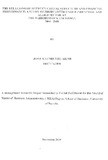| dc.description.abstract | The purpose of this study was to establish the relationship between capital structure and return on equity for industrial and allied sectors in the Nairobi Stock Exchange. The study explored the relationship between the capital structure proxied by debt equity ratio and performance proxied by return on equity during the period 2004 and 2008. The focus was on the firms listed under the industrial and allied sector at the NSE.
The main objective of this study was to establish the relationship between . debt equity ratio (DER) and return on equity (ROE) for Industrial and Allied Sector (lAS) companies listed at the NSE. The research design was a descriptive survey. The population of the study consisted of all the companies quoted on the NSE under the Industrial and Allied Sector. All the companies under this sector were sampled except for those that were not continuously listed during the period. Secondary data was utilized for the study. Data was collected by the aid of checklist.
Data analysis was done by forming a trend analysis to enable determination of the impact of debt equity ratio on ROE. Yearly debt equity ratio, the proxy for capital structure, and ROE were calculated and tabulated. Additionally a regression analysis on DER and ROE was performed to determine the strength and direction of the DER-ROE relationship. The data was presented in tables and graphs.
The effect of DER differed across the various companies in terms of magnitude and direction. A negative relation was noted between debt equity ratio and ROE, thus an increase in debt equity ratio caused a decrease in ROE. The regression analysis yields a correlation coefficient of -0.0241 implying a negative relationship between debt equity ratio and return on equity. The study therefore concludes that there is a negative relationship between debt equity ratio and ROE.
The findings are consistent with the traditional capital structure theory. The pecking order theory predicts that firms will use retentions first, then debt and equity issues as a last resort. The order of preferences reflects the relative costs of various financing options. Less profitable firms facing a positive NPV investment opportunity will be more willing to use external funds if cash flows are weak. Therefore, there will be a negative relationship between leverage and profitability.
The recommendations of the research are that further study be done to cover a representation of all the Kenyan companies, a study be carried out to establish the determinants of capital structure in Kenya, as well as a study to determine the relationship between dividend policy and capital structure in Kenya. | en_US |

